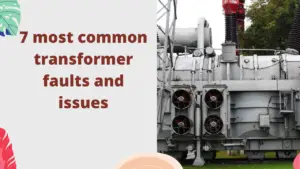Transformers are essential devices in electrical systems, widely used for power transmission and voltage regulation.
However, transformers are specifically designed to work with AC (alternating current) power rather than DC (direct current) power.
Transformers cannot work on DC because they rely on the alternating current’s changing magnetic field to induce voltage in the secondary winding, a characteristic absent in direct current.
In this article, we will explore the reasons behind the incompatibility of transformers with DC and the consequences of applying DC to these devices.
Table of Contents
Understanding Transformers
Transformers are electromagnetic devices that transfer electrical energy between two or more circuits using the principle of electromagnetic induction.
They consist of two coils of wire, known as primary and secondary windings, which are wound around a magnetic core.
The primary winding receives electrical power, while the secondary winding delivers the transformed voltage.
DC Power and its Characteristics
DC power is the constant flow of electric charge in a single direction. Unlike AC power, which oscillates in a cyclical manner, DC power maintains a steady voltage level.
DC power offers various advantages and finds applications in areas such as battery-powered devices, electronic circuits, and certain specialized systems.
Why Transformers cannot work on DC
Transformers operate based on the principle of electromagnetic induction. Alternating current (AC) continuously changes direction, creating a fluctuating magnetic field that induces voltage in the secondary winding of the transformer. This induction allows for voltage transformation and efficient power transfer.
However, direct current (DC) does not have the alternating nature of AC. As a result, the absence of changing magnetic fields eliminates the induction process required for transformers to function.
Without the fluctuating magnetic field, there is no voltage induction in the secondary winding, rendering transformers ineffective for DC power transmission.
Limitations of Transformers
Transformers are designed to operate specifically with AC power. This limitation arises due to fundamental differences between AC and DC power.
AC power alternates in direction, creating a changing magnetic field that induces a voltage in the secondary winding.
On the other hand, DC power lacks this alternating characteristic, leading to challenges for transformers.
Factors Influencing Transformer Operation
Several factors affect the operation of transformers, making them incompatible with DC power. One such factor is inductive reactance, which impedes the flow of DC current through the transformer windings.
Additionally, magnetic core saturation, a phenomenon where the magnetic properties of the core material reach their limits, poses another limitation.
Furthermore, transformers are designed and optimized for specific frequencies, typically the standard AC power frequencies.
Read also my article: AC vs DC Power (Read This First).
Consequences of Applying DC to Transformers
Applying DC power to transformers leads to several consequences due to their design and operational characteristics.
Firstly, in the absence of alternating current, transformers cannot induce a voltage in the secondary winding, resulting in a lack of voltage transformation.
Consequently, the primary and secondary sides would have the same voltage, rendering the transformer ineffective.
Secondly, the absence of alternating current can cause excessive current flow through the windings, leading to overheating and potential damage to the transformer. This increased current flow is a consequence of reduced impedance in the absence of inductive reactance.
Lastly, applying DC power to transformers increases the risk of core saturation. In AC operation, the periodic change in magnetic field direction allows the core to partially demagnetize during each cycle.
In DC operation, however, the magnetic field remains constant, potentially causing the core to saturate and adversely affect the transformer’s performance.
Read also: Transformer Overheating? Here’s How to Cool It Down Quickly and Safely
Alternatives for DC Power Conversion
To overcome the incompatibility between transformers and DC power, alternative conversion methods are employed.
Rectifiers are commonly used to convert AC to DC power by employing diodes to allow current flow in a single direction.
Choppers, which are electronic switches, can convert DC voltage to a higher or lower level using pulse width modulation (PWM) techniques.
DC-DC converters are also utilized to step up or step down DC voltage levels efficiently.
Practical Considerations
In scenarios where isolation is required, such as in medical equipment or certain industrial applications, isolation transformers can be used to provide galvanic isolation between the input and output circuits.
Additionally, transformerless DC power supplies, which utilize electronic components instead of transformers, offer compactness, higher efficiency, and reduced cost for certain low-power applications.
DC power distribution systems, commonly found in renewable energy installations and electric vehicles, employ specialized DC transformers or power electronic devices capable of handling high DC voltages and currents efficiently.
Conclusion
Transformers are remarkable devices for power transformation in AC systems, but they are not designed to work with DC power due to the absence of alternating currents and the inherent characteristics of transformers.
Attempting to use transformers with DC power can result in ineffective voltage transformation, excessive current flow, and an increased risk of core saturation.
Therefore, alternative methods such as rectifiers, choppers, and DC-DC converters are employed for efficient DC power conversion, depending on the specific application requirements.
By understanding the limitations and exploring appropriate alternatives, efficient and reliable DC power systems can be achieved.
Install my Free Android App on Google Play:
Electrical Cables Most Common Tables
And, my Electrical Calculations App “”
Discover more great content by subscribing to My channel
Looking to stay ahead of the game in the world of electrical engineering? Subscribe to my YouTube channel and gain access to exclusive content you won’t find anywhere else!
The staff I recommend
(Amazon Affiliate Links to products I believe are high quality):
- Economy 120 Volt/60Hz AC Power Source – Step-Down Voltage & Frequency Converters 1800W
- UNI-T Digital Multimeter Tester UT139C
- 50-Amp Extension Cord for RV “100ft”
- Voltage Stabilizer 110/220v
- Hair Dryer “best selling“
- TOSHIBA EM131A5C-BS Countertop Microwave Ovens
Disclaimer: This contains affiliate links to Amazon products. I may earn a commission for purchases made through these links.


